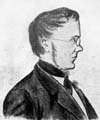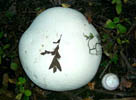Terms discussed: acetocarmine, acyanophilic, amyloid, cyanophilic, cyanophilous, inamyloid, KOH, Melzer's solution, nonamyloid, siderophilous, slightly amyloid
A variety of chemical tests are used to help identify mushrooms.
It may seem like an unnecessary warning, but: most of these chemicals are poisonous, and you won't want to eat the tissue that has been tested with them.
Topics:
amyloid
dextrinoid
cyanophilous
siderophilous
amyloid
If the fungal tissue contains starch, it will turn navy blue when tested with an iodine solution. This is called an amyloid reaction. Inamyloid spores or context don't change color.
Rolf Singer sometimes invokes a "slightly amyloid" reaction, where the fungal tissue turns yellow or pale brown.
One most commonly checks white spores to see if they are amyloid, but context gets checked fairly regularly also.
Back to top
The iodine solution of choice is Melzer's solution (or sometimes Melzer's reagent), a combination of iodine with methyl chloride and potassium iodide.
dextrinoid
The other major reaction to Melzer's solution is a dextrinoid reaction, changing to reddish-brown. As with the amyloid reaction, it is mainly a test for spores, but is sometimes used on context.
cyanophilous
Cyanophilous mushroom tissue turns red in acetocarmine. One usually checks spores or basidia for this property.
siderophilous
Siderophilous tissues darken dramatically when heated in acetocarmine. This is usually a property of the basidia.











